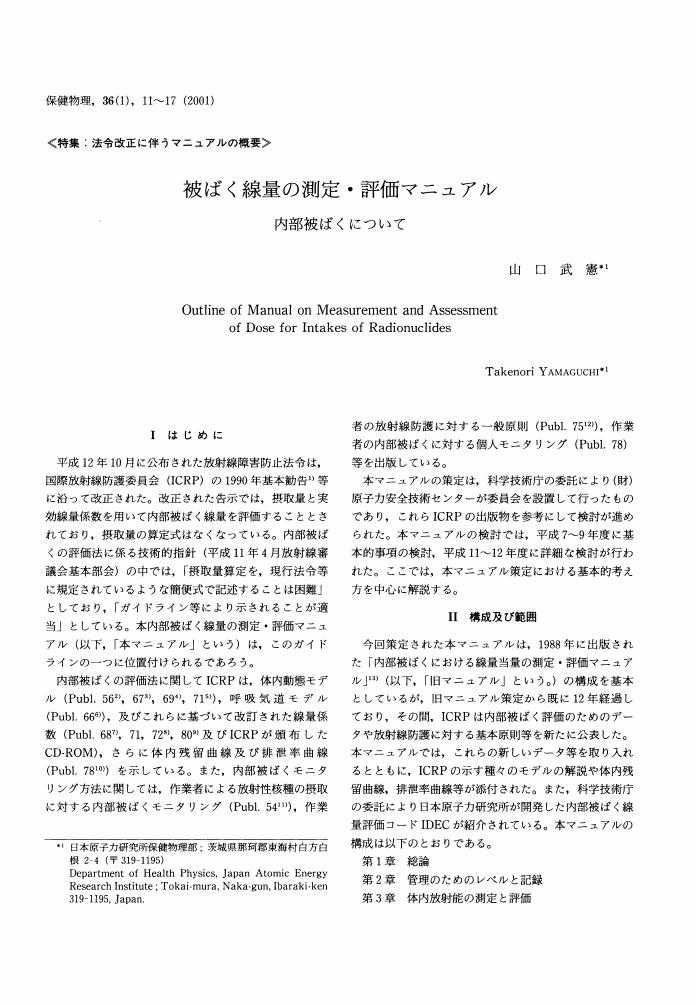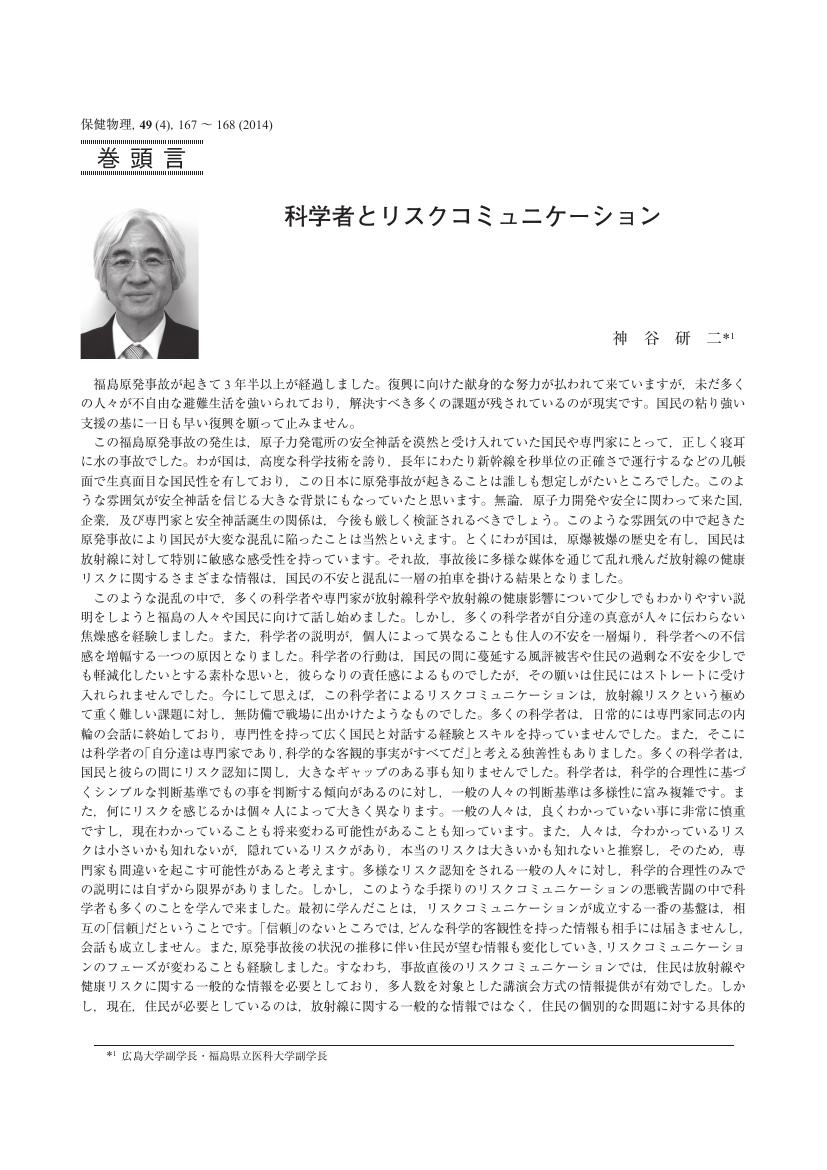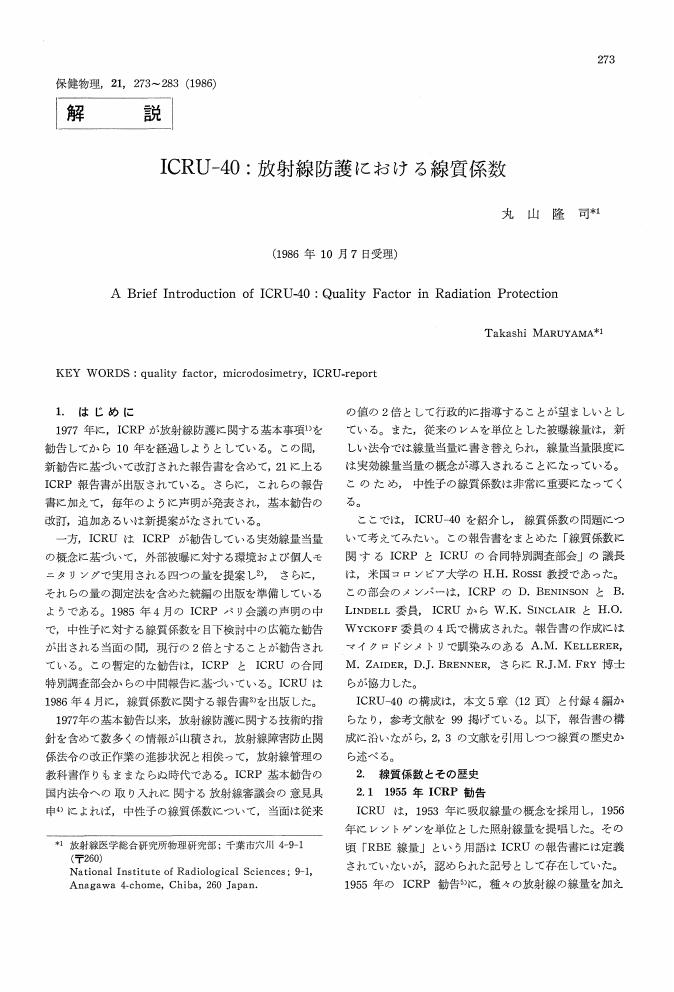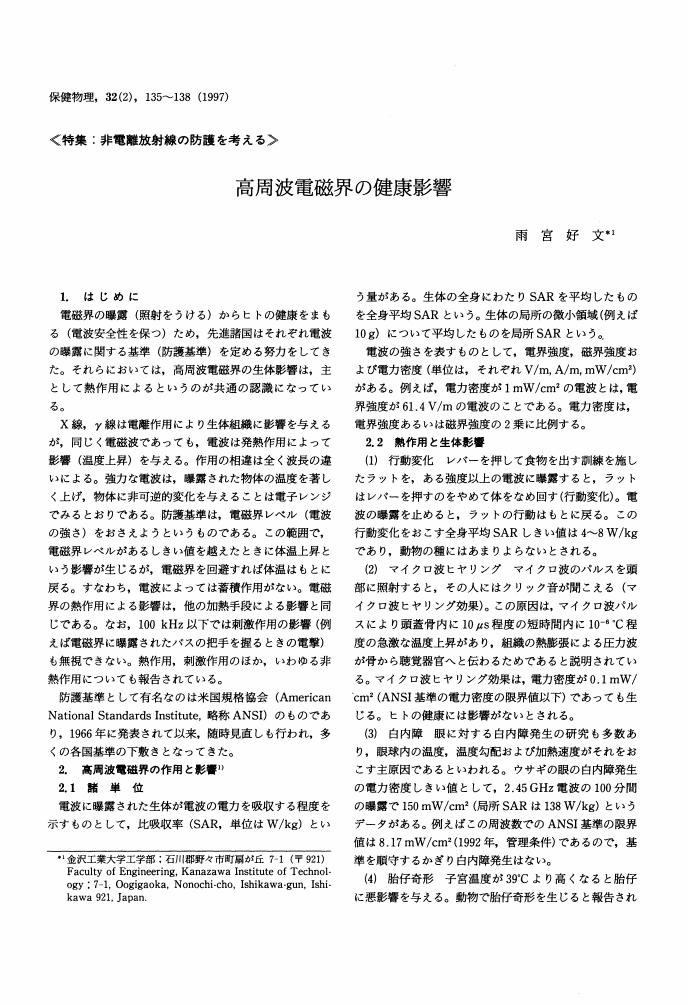5 0 0 0 OA 被ばく線量の測定・評価マニュアル内部被ばくについて
5 0 0 0 OA 放射線管理コーナー (第34巻3号)
- 著者
- 吉澤 道夫 水下 誠一 日本学術会議 核科学総合研究連洛委員会原子力基礎
- 出版者
- 日本保健物理学会
- 雑誌
- 保健物理 (ISSN:03676110)
- 巻号頁・発行日
- vol.34, no.3, pp.319-324, 1999 (Released:2010-02-25)
- 参考文献数
- 2
- 被引用文献数
- 1
放射線や放射性同位元素の利用は, 基礎及び応用の諸科学, 工業, 農水産業, 医療等の広い分野で進められ, 現在の社会にとって欠かすことの出来ない手段となっている。一方, 放射線や放射性同位元素はその発見当時から人体への影響が研究され, 不用意な被ぼくが悪影響を及ぼすことが知られてきた。このために, 安全のための規制が設けられ, その取扱いは厳重な管理の下に行われている。わが国で放射性同位元素等による放射線障害の防止に関する法律 (以下「放射線障害防止法」という。) が定められた当時, 放射性同位元素の利用は, 原子炉等で製造された物を入手して利用するという形態であり, 短時間に減衰し消滅する放射性同位元素は, 加速器を用いた原子核の研究など限られた場所と分野以外には利用の方法が無かった。このため現在の規制は, 短時間に消滅する放射性同位元素を扱うことを想定していない。近年, 医療の分野では, 加速器を用いて短寿命の放射性同位元素を製造し, 人体機能の研究や診断に用いる技術が大きく発展し, 生理学的・生化学的機能を調べる上で欠かすことの出来ない重要な手法となっている。このような手法が医療行為として行われる場合には医療法による規制を受け, 研究に用いる場合には, 放射線障害防止法の規制を受ける。しかし, 研究や診断に用いた短半減期放射性同位元素は短時間に消滅するので, 使用した器具, 投与した動物などは一定の短期間管理すれば, 現在のような放射線管理の必要はなく, その取扱いについて特別の考慮が必要である。このため, 当専門委員会では, 前期に引き続き今期当初より陽電子放出断層撮影 (PET) の使用に係る安全性について, ワーキンググループを設置し検討してきた。検討の結果PETに使用される短半減期放射性同位元素の使用に関する規制について以下のように適正化することを提言する。「短半減期放射性同位元素を用いた放射性薬剤として製造法が確立され, 長半減期放射性同位元素の混入してないことが確認された薬剤について, これを使用した器具, 投与された動物などは, 期間を定めて管理した後, 定められた測定方法により安全性が確認された場合, 放射性物質で汚染されたものとしての管理の必要のないものとして処理できることとする。安全性の確認法, PET用放射性薬剤以外の放射性同位元素の混入防止策等について指針を定めて早急に実施すること。」
- 著者
- 佐藤 友樹
- 出版者
- 日本保健物理学会
- 雑誌
- 保健物理 (ISSN:03676110)
- 巻号頁・発行日
- vol.54, no.2, pp.137-139, 2019-06-17 (Released:2019-10-18)
- 著者
- 神田 玲子 辻 さつき 米原 英典
- 出版者
- 日本保健物理学会
- 雑誌
- 保健物理 (ISSN:03676110)
- 巻号頁・発行日
- vol.49, no.2, pp.68-78, 2014 (Released:2015-05-21)
- 参考文献数
- 9
- 被引用文献数
- 5 3
In general, the press is considered to have amplified the level of public's anxiety and perception of risk. In the present study, we analyzed newspaper article headlines and Internet contents that were released from March 11, 2011 to January 31, 2012 using text mining techniques. The aim is to reveal the particular characteristics of the information propagated regarding the Fukushima NPP Accident. The article headlines of the newspapers which had a largest circulation were chosen for analysis, and contents of Internet media were chosen based on the number of times they were linked or retweeted. According to our text mining analysis, newspapers frequently reported the “measurement, investigation and examination” of radiation/radioactive materials caused by the Fukushima Accident, and this information might be spread selectively via the social media. On the other hand, the words related to health effects of radiation exposure (i. e., cancer, hereditary effects) were rare in newspaper headlines. Instead, words like “anxiety” and “safe” were often used to convey the degree of health effects. Particularly in March of 2011, the concept of “danger” was used frequently in newspaper headlines. These indirect characterizations of the situation may have contributed more or less to the misunderstanding of the health effects and to the enhanced perception of risk felt by the public. In conclusion, there were found no evidence to suggest that newspapers or Internet media users released sensational information that increased the health anxiety of readers throughout the period of analysis.
4 0 0 0 OA 個人装飾品に含まれる放射性物質 ―放射能濃度と被ばく線量の検討
- 著者
- 古田 悦子
- 出版者
- 日本保健物理学会
- 雑誌
- 保健物理 (ISSN:03676110)
- 巻号頁・発行日
- vol.45, no.3, pp.253-261, 2010 (Released:2011-07-12)
- 参考文献数
- 15
Recently many Japanese wear jewelry as personal ornaments, particularly bracelets. The jewelry is made of gems, jewels, noble metals and so on. Some kinds of jewelry include much amount of radioactive elements more than that of natural range in ores which are in our living-environment. The radioactive concentrations of 25 kinds of jewels and gems, which were easily purchased on a market or through the Internet, were analyzed by HPGe. The bracelet which was made of ceramics showed the highest radioactive concentration and it was estimated as approx. 800 Bq g-1 of 232Th and 140 Bq g-1 of 238U by assuming radioactive equilibrium among the nuclides in the decay series. Moreover, there was a high radioactive concentration gem including 60 Bq g-1 of 232Th and 300 Bq g-1 of 238U. The radioactive materials added in the ceramics should be monazite analyzed by a prompt gamma-ray activation analysis method. Though the ceramics became the object of the NORM management by the concentration, the radioactivity of one bracelet does not exceed 8,000 Bq. So, all these jewelry samples do not have to manage as NORM as consumer products according to the guideline by Japanese government. However, the jewelry's activity by deliberate addition of radioactive materials is deemed to be unjustified exposure, that the ICRP led the consideration. It is considered that the NORM guideline should take in the consideration of ICRP and prohibit the addition of radioactive materials to jewelry.
4 0 0 0 OA 科学者とリスクコミュニケーション
- 著者
- 神谷 研二
- 出版者
- 日本保健物理学会
- 雑誌
- 保健物理 (ISSN:03676110)
- 巻号頁・発行日
- vol.49, no.4, pp.167-168, 2014 (Released:2015-12-18)
- 被引用文献数
- 1
4 0 0 0 OA 保健物理と放射線被ばく事故
- 著者
- 明石 真言
- 出版者
- 日本保健物理学会
- 雑誌
- 保健物理 (ISSN:03676110)
- 巻号頁・発行日
- vol.54, no.3, pp.149-150, 2019-10-29 (Released:2019-11-21)
4 0 0 0 OA ICRU-40: 放射線防護における線質係数
- 著者
- 丸山 隆司
- 出版者
- Japan Health Physics Society
- 雑誌
- 保健物理 (ISSN:03676110)
- 巻号頁・発行日
- vol.21, no.4, pp.273-283, 1986 (Released:2010-02-25)
- 参考文献数
- 18
- 著者
- 山田 純也 橋本 周 瀬谷 夏美 羽場 梨沙 武藤 保信 清水 武彦 高崎 浩司 横山 須美 下 道國
- 出版者
- 日本保健物理学会
- 雑誌
- 保健物理 (ISSN:03676110)
- 巻号頁・発行日
- vol.52, no.1, pp.5-12, 2017 (Released:2017-04-22)
- 参考文献数
- 9
- 被引用文献数
- 2
The purpose of this study is to improve a quick method for estimation of 131I concentrations in the air using data measured by monitoring posts in case that a nuclear disaster occurs. In this method, 131I concentrations were estimated by multiplying 131I count rates of cloud-shine measured with Na(Tl) detector by concentration conversion factor. A previous study suggested that it was difficult to determine passing-through time of plume from temporal change of 131I count rates or dose rate. Our study applies the method for estimating passing-through time of plume from temporal change of noble gas counts. The 131I concentrations in the air at Oarai center, Japan Atomic Energy Agency resulting from the accident at the Fukushima Daiichi Nuclear Power Station were estimated by proposal technique. The result of comparison of this method with sampling method for 131I concentrations in the air were within factor 3.
4 0 0 0 OA 弘前大学による福島県浪江町復興支援プロジェクトの概要
4 0 0 0 OA 下水汚泥中に含まれる核医学で使用されている核種の放射能濃度及び被曝線量評価
- 著者
- 鈴木 隆司 岡野 安宏 杉浦 城春 猪越 幸雄
- 出版者
- 日本保健物理学会
- 雑誌
- 保健物理 (ISSN:03676110)
- 巻号頁・発行日
- vol.33, no.2, pp.163-170, 1998 (Released:2010-02-25)
- 参考文献数
- 16
- 被引用文献数
- 1 2
The concentrations of medically used radionuclides in activated sludge samples were measured for 10 waste water treatment plants (WWTP) in Tokyo from October 1983 to March 1994. The nuclides 99mTc, 67Ga, 111In 123I 131I and 201Tl, among others, could be detected, but these concentration levels were lower than the legal concentration limits in Japan. The excess activated sludge is usually incinerated at WWTP; then the resulting ash is transported for reclamation in Tokyo Bay. Internal and/or external exposure doses were evaluated for the following cases: (1) The dose of the public attributed to radioactive iodine and 201Tl, which were released from the incinerator by burning sludge; (2) The dose of the workers during the process of transport and reclamation of the ash. As a result, the effective doses were sufficiently lower than the dose limit 1mSv/y. The decay of the radionuclides were calculated over a period of curing of the landfill. It was found that the radionuclides had decayed out to approximately one nuclide. The effective dose of the public can therefore be ignored. Moreover, it was clarified that the effective dose of the public resulting from 99Tc is negligibly low in value at the present time.
4 0 0 0 OA 福島第一原子力発電所事故に関する放射線防護上の課題
- 著者
- (社) 日本保健物理学会理事会
- 出版者
- 日本保健物理学会
- 雑誌
- 保健物理 (ISSN:03676110)
- 巻号頁・発行日
- vol.47, no.2, pp.83-92, 2012 (Released:2012-12-07)
- 被引用文献数
- 1 1
4 0 0 0 「屋内ラドンの規制に対する日本保健物理学会の提言」について
- 著者
- 古田 定昭
- 出版者
- 日本保健物理学会
- 雑誌
- 保健物理 : hoken buturi (ISSN:03676110)
- 巻号頁・発行日
- vol.41, no.1, pp.9-10, 2006-03-01
4 0 0 0 OA 内装建材による内部・外部被ばく線量評価(第2部:和文)
- 著者
- 古田 悦子 森田 裕子 吉沢 幸夫
- 出版者
- 日本保健物理学会
- 雑誌
- 保健物理 : hoken buturi (ISSN:03676110)
- 巻号頁・発行日
- vol.42, no.4, pp.341-348, 2007-12
- 被引用文献数
- 1 2
Internal exposure to alpha particles emitted from <222>^Rn (radon) and its daughters is the second leading cause of lung cancer. As a source of indoor radon in home, there are interior building materials that contain radioactive minerals. These radioactive consumer products have been claimed by distributors to have effect of "minus-ion" or "radon spring" for healthy promotion. We analyzed radioactive nuclides contained in the interior building materials, and measured radon levels released from them. The results of gamma-ray spectrometry revealed that these interior building materials contain U- and Th-series nuclides. The densities of some radioactive nuclides in the tile used for a bathroom exceeded the exempt limits of International Basic Safety Standards. However, the radon densities released from the tile was lower than detectable limit. In contrast, one of the wallpaper released 34Bq・m^<-3> of radon gas in a 50-liter container. This value is two times higher than the average radon level in Japanese homes. The "minus-ion effect" wallpapers are thought to be a cause of residential exposure to radon.
- 著者
- 嶋田 和真
- 出版者
- 日本保健物理学会
- 雑誌
- 保健物理 : hoken buturi (ISSN:03676110)
- 巻号頁・発行日
- vol.42, no.2, pp.135-136, 2007-06
3 0 0 0 OA 空間ガンマ線量率への黄砂の影響
3 0 0 0 OA イリジウム-192による被曝事故について
- 著者
- 熊取 敏之 加藤 義雄
- 出版者
- Japan Health Physics Society
- 雑誌
- 保健物理 (ISSN:03676110)
- 巻号頁・発行日
- vol.9, no.1, pp.17-21, 1974 (Released:2010-02-25)
- 参考文献数
- 6
3 0 0 0 OA 高周波電磁界の健康影響
- 著者
- 雨宮 好文
- 出版者
- Japan Health Physics Society
- 雑誌
- 保健物理 (ISSN:03676110)
- 巻号頁・発行日
- vol.32, no.2, pp.135-138, 1997 (Released:2010-02-25)
- 参考文献数
- 2












